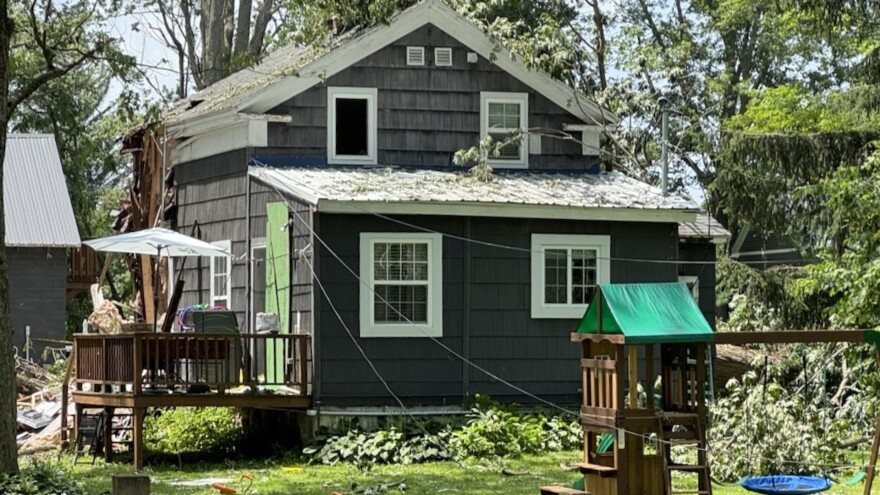On Clinton Road, where it bisects the Hamlet of Clark Mills’ on the northern end of the Town of Kirkland, birds had returned to their roosts. Some of their nests now sit on broken branches of massive trees that once served as a proud canopy shading residents on hot summer days.
“There's a lot of huge maples,” Bob Meelan accounted for in his own neighborhood, “I mean huge maples, pine trees, a lot of pine trees, and they don’t have strong roots.”
He’s Kirkland’s Town Supervisor. When the EF-1 tornado touched down the morning of June 23, it plucked several of the 50-foot maples, pines, and ash trees at random. It did not care about the power lines, roads, and houses below.

“Every second, it was like boom, boom, boom,” Toni Hoffmeister recalled as lightning strikes left no gap between the thunderclaps. She admittedly moved slowly as the dark clouds carried the cyclone within 100 feet of her home.
“I was in shock,” Hoffmeister recalled, not because of the storm’s enormity, but because tragedy had personally hit two days earlier. “My husband just died… he was 63. So now, I’m all alone.”
Racked with grief, in a tiny home with no basement and only one closet, she gathered her strength to take cover, “I was getting ready to go into the closet, but then I was like, ‘That wasn’t a tornado, or was it?’”
The National Weather Service later confirmed it was an EF-1 tornado whipping through the town at 105 miles per hour at 3:58 a.m. on Sunday.
At its deadliest, it killed 50-year-old Shelly Johnson as she slept in her mobile home. Within seconds of each other it also struck Hoffmeister’s neighbor’s two-story home killing twin 6-year-old girls asleep in their beds.
“It’s just really sad, you know, they’re so young.” Hoffmeister choked back tears thinking about the irony of losing so much, “He was 63, he still had a long lifetime,” she thought aloud about her husband, then the girls, “I can't even imagine what their parents are going through.”

The sadness hung in the humid air the next morning as Supervisor Meelan set out to inventory the damage and make a call to Oneida County leaders.
“I declared a state of emergency,” Meelan explained, foreseeing the challenges ahead for residents also uprooted by the storm. “If there’s funding out there it will help the people.”
It also allows search and rescue, as well as utility services to enter private property to render aid, remove fallen debris, and restore power, water, and sewer lines damaged in the storm’s wake.
At the same time, neighbors armed with rakes and plastic bags, scooped up debris. Emergency crews drove front loading bulldozers at dizzying speeds quickly removing larger branches, while linemen hoisted high in cherry pickers reconnected vital power cables. Some neighbors came from the next town over to lend a hand.

“Yeah, this isn’t my normal line of work,” Dylan McDonough said while firing up his industrial chain saw to cut up a felled tree.
He had driven 24 miles from Newport where he normally works as a logger, but recent rain had put that work on hold.
“Since it’s too wet to pull trees,” he said, “I figure I’d try to help some folks out, you know.”
He fired up the gas-powered chainsaw once more and began cutting up another 50-foot tree. It had miraculously fallen during the storm away from the home of an 83-year-old man who, like so many, endured it alone.
It’s that neighborly spirit of which Meelan is proudest. Sometimes, looking out for someone else can help the tiniest of towns survive the biggest blows.

“Look out for your neighbor,” Meelan urged. “If you’ve got an older neighbor next to you and you think they're in trouble? Get a hold of them.”
Residents who have problems with housing, removing trees and debris, or are in need of food, water, and clothing, the Town of Kirkland’s council has set up services at its Senior Center on Mill and New Streets.
For anyone caught in a severe heat or a storm’s aftermath this season, contact The Central & Northern New York Red Cross to learn where immediate housing, cooling centers, and water are located. The organization also aids in connecting residents in distress with local and federal agencies that provide disaster relief assistance.



